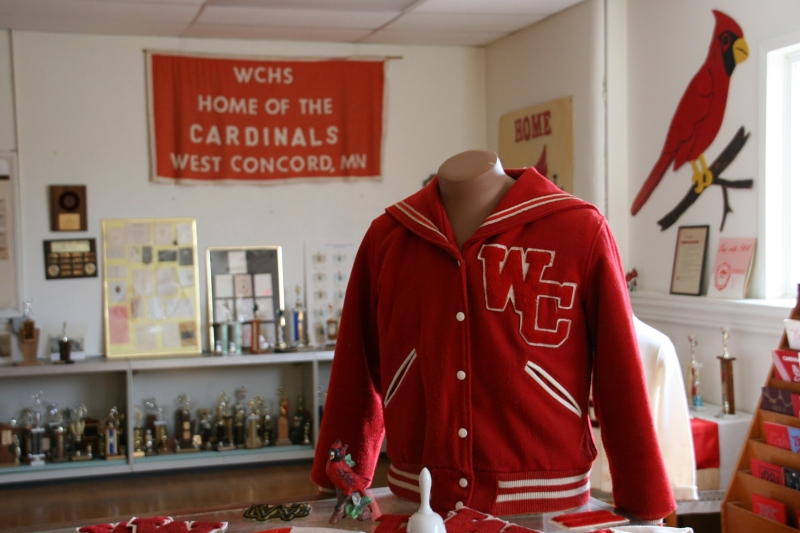EVERY COMMUNITY NEEDS a Janis Ray and a team of equally enthusiastic volunteers.
“We’re the keeper of the history,” says 86-year-old Janis, former educator and a current director/gambling manager of the West Concord Historical Society.

The 1902/1914 school is on the left, the 1936 gym on the right. Museum left, community center right. To enter, use the door between the buildings, in the area where the red car is parked in this photo. The school closed in 1991.
My husband and I met Janis recently while on a meandering day trip to several small towns in southeastern Minnesota. In West Concord, population hovering near 800, we happened upon the historical society and community center housed in an old school. After the school closed in 1991, the WCHS purchased the 1902/1914 building and the attached 1936 gym for $1, saving the complex from planned demolition. Several years later, the museum opened in this hulk of a multi-story brick building, the kind that can never be replaced in character and visual strength by a new facility.
I appreciate this museum, this building, even though I have no personal connection to the West Concord area.
This structure houses not only local history, but everyone’s history. Or at least everyone who grew up in rural Minnesota. I delighted in room after former classroom themed to topics like veterans, fashion, farmers and merchants, education, the 1950s and 60s, heritage and more. Even hallways hold small town rural treasures.
Reminders of the building’s former use linger in blackboards, globes, pull-down maps and the “Principal’s Office” sign above The Farmers & Merchant Room doorway. You can almost hear students slamming locker doors and shuffling across worn wood floors.
I know I missed a lot simply because we arrived too late to study the three stories of collections in detail. The place closes at noon Saturdays and Janis was gracious enough to let us stay a bit past closing. Yet I left impressed. This is one of the finest small town museums I’ve ever toured.
And, Janis will tell you, the largest in the area. She is proud of what this community has created. She graduated from this school and taught elementary school students here for 36 years. Her roots run deep.
Perhaps that is what appeals to me—that personal connectedness spawning passion unquelled. You can’t match small town enthusiasm that brings locals like Janis here to volunteer 25 hours a week. She manages the liquor store pulltab fundraising which brings in $10K-$12K yearly to help meet annual historical society expenses of around $70K. Membership (there are 260 members from 24 states) and donations provide the remaining bulk of financial support. There’s no paid staff.
Janis is serious about this business of keeping the history. She delights in young people coming here with their parents or grandparents, generations passing along the histories of this community and building to another generation.

The museum feels living room comfortable. This 1950s living room staged in The 50’s and 60’s Room includes the first TV (a 1950 model on the left in this photo) sold in West Concord.
I felt at ease here, unencumbered by rules. Photography is allowed. You can meander among the exhibits; no ropes or half-walls fence you out. There’s a certain comfortableness that prevails, as if everything here belongs to you, even when it doesn’t. But perhaps it does.
FYI: The museum is open from 9 a.m. – 2 p.m. weekdays and from 10 a.m. – noon Saturdays. Or call 507-527-2628 for an appointment. The museum is located at 600 West First Street, a block west of Highway 56 at the intersection with Olive Street. Click here to reach the WCHS website.
I will showcase the museum in two more posts because I have way too many images for a single story. And then I’ll take you into the West Concord High School gym built as a WPA project in 1936. It’s a treasure, too.
© Copyright 2015 Audrey Kletscher Helbling

























































Recent Comments